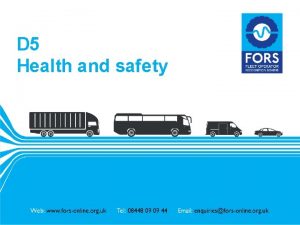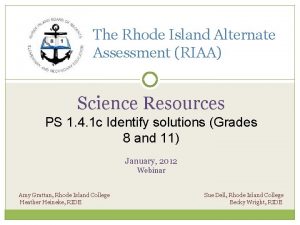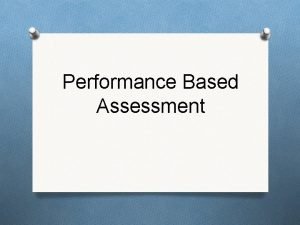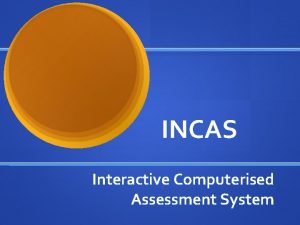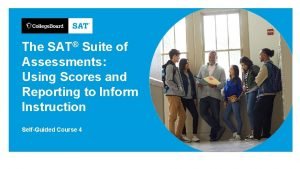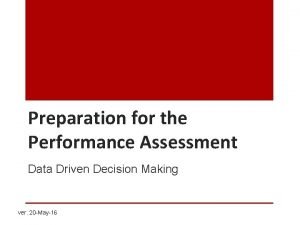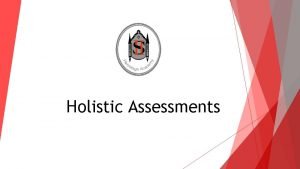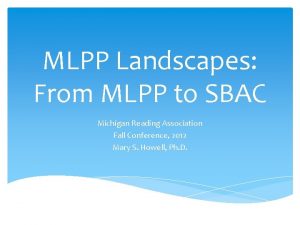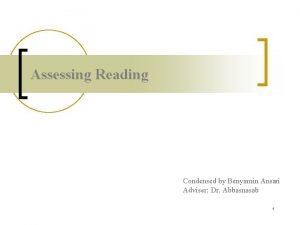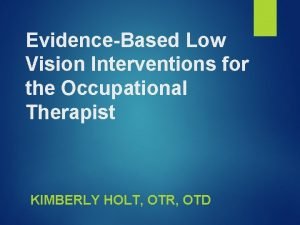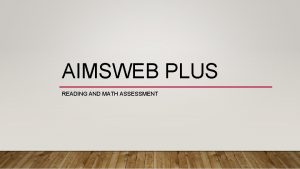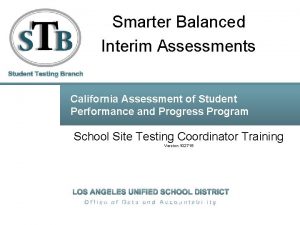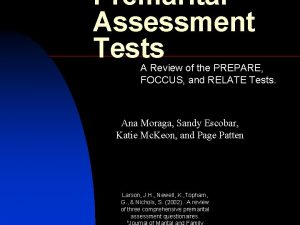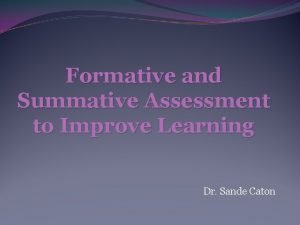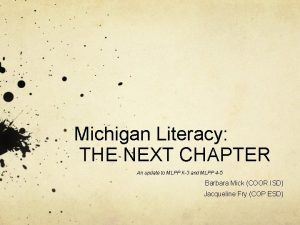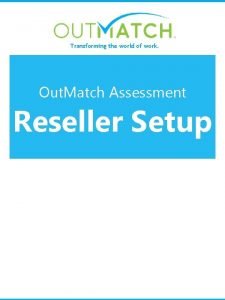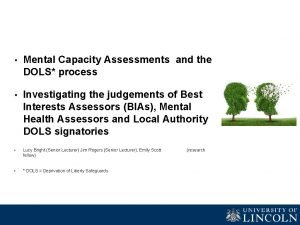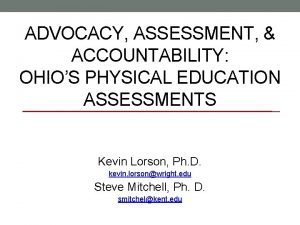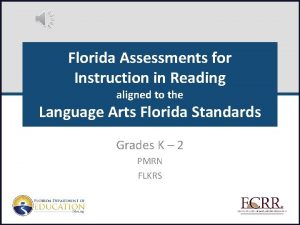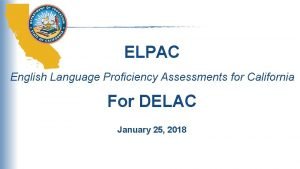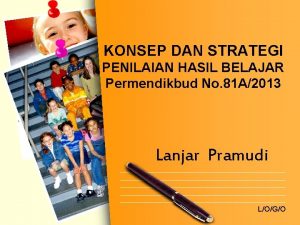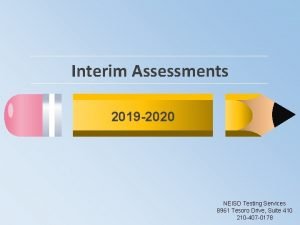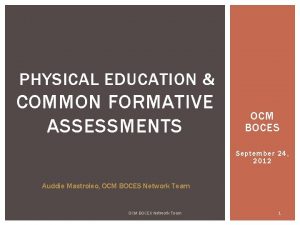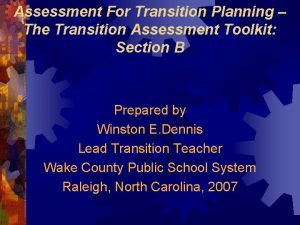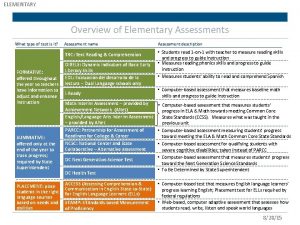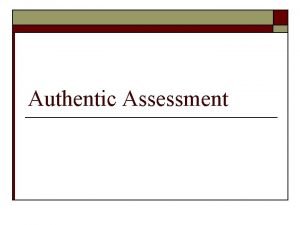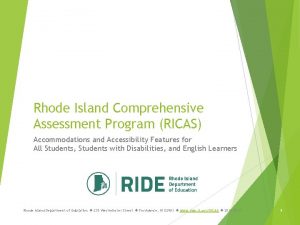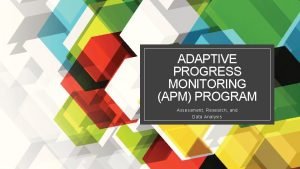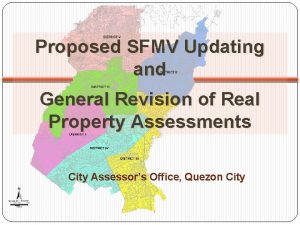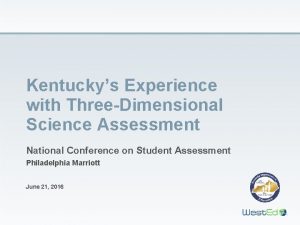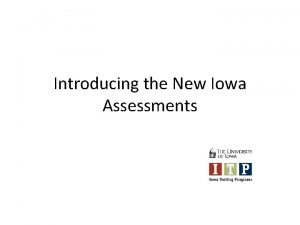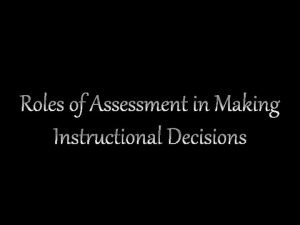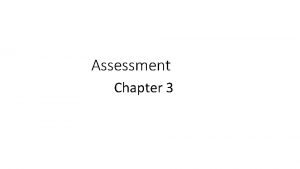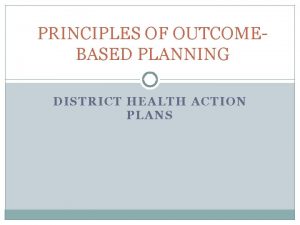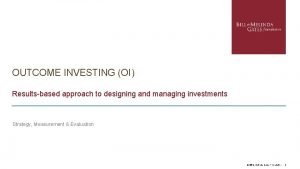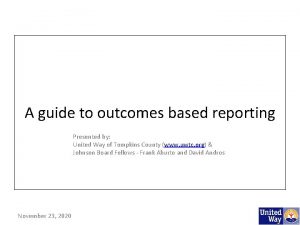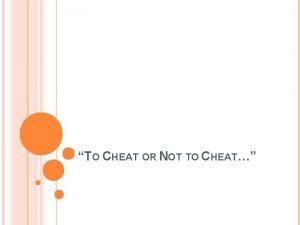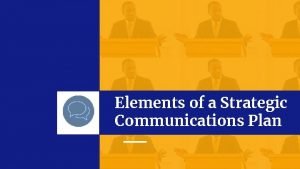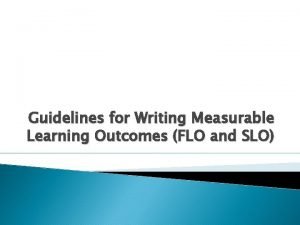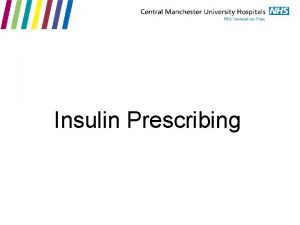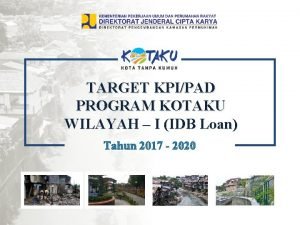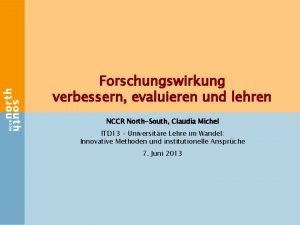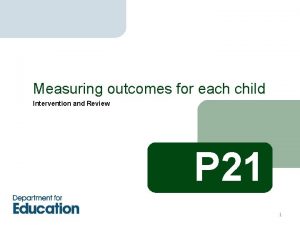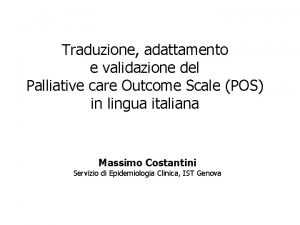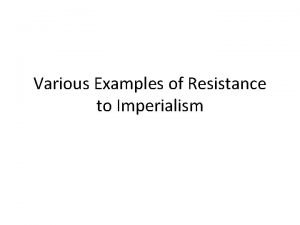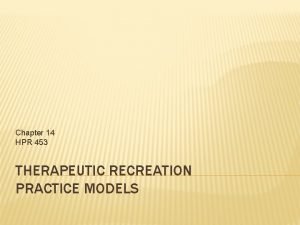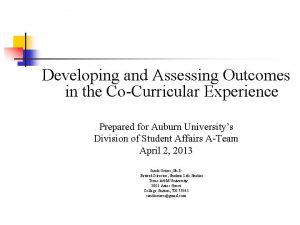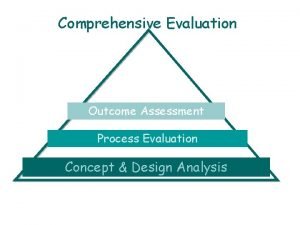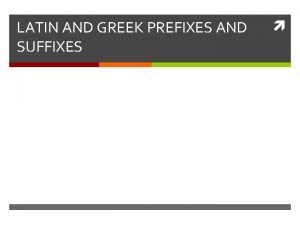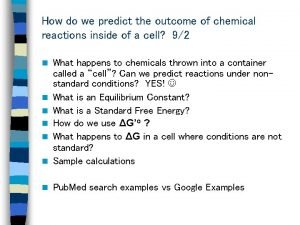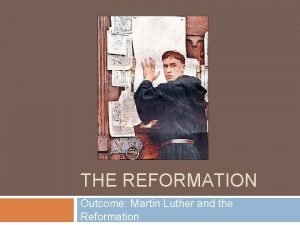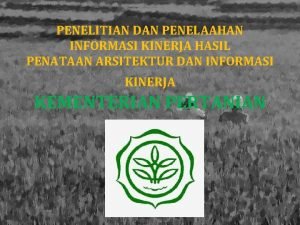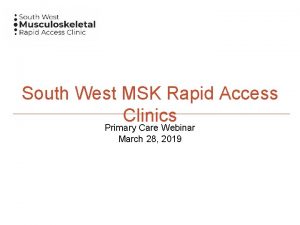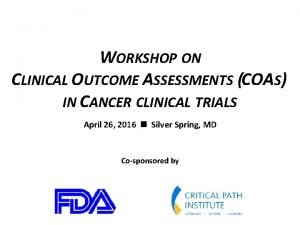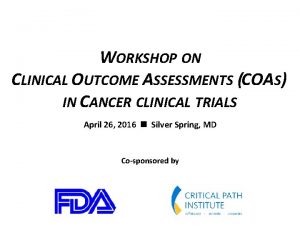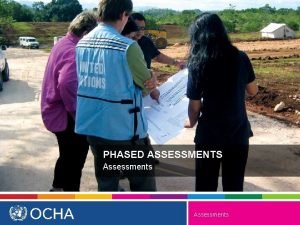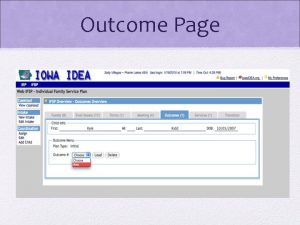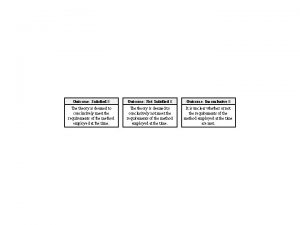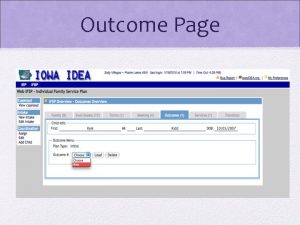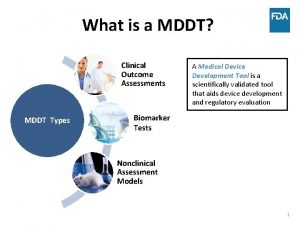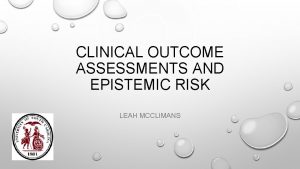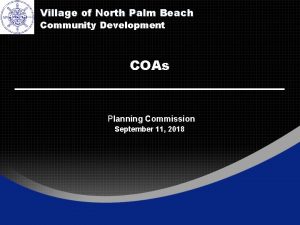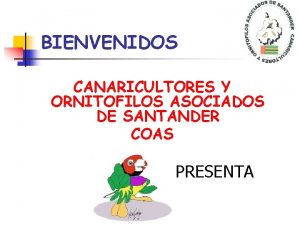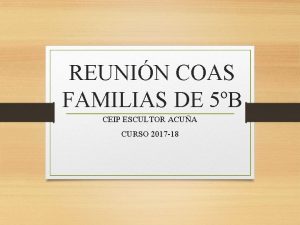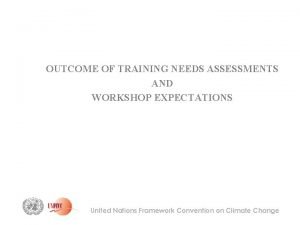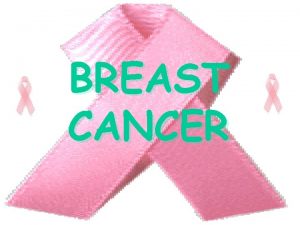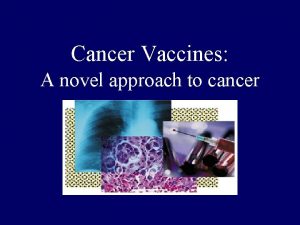WORKSHOP ON CLINICAL OUTCOME ASSESSMENTS COAS IN CANCER














































































- Slides: 78

WORKSHOP ON CLINICAL OUTCOME ASSESSMENTS (COAS) IN CANCER CLINICAL TRIALS April 26, 2016 Silver Spring, MD Co-sponsored by

Session 3 Existing Options for Assessing Patient-Reported Physical Function WORKSHOP ON CLINICAL OUTCOME ASSESSMENTS (COAS) IN CANCER CLINICAL TRIALS April 26, 2016 Silver Spring, MD Co-sponsored by

Disclaimer • The views and opinions expressed in the following slides are those of the individual presenters and should not be attributed to their respective organizations/companies, the U. S. Food and Drug Administration or the Critical Path Institute. • These slides are the intellectual property of the individual presenters and are protected under the copyright laws of the United States of America and other countries. Used by permission. All rights reserved. All trademarks are the property of their respective owners.

Session Participants Chair – Paul G. Kluetz, MD – FDA Presenters – Ethan Basch, MD – University of North Carolina – Selena Daniels, Pharm. D, MS – FDA – Mogens Groenvold, MD, Ph. D, DSci – University of Copenhagen – David Cella, Ph. D – Northwestern University Feinberg School of Medicine Panelists – Wen-Hung Chen, Ph. D – FDA – Daniel O’Connor, MD – MHRA, EMA – Ashley Wilder Smith, Ph. D, MPH – NCI

The Value of Physical Function Assessment in Cancer Clinical Trials: A Clinician Perspective Ethan Basch, MD April 2016

Why Clinicians Care about Physical Function ØAbility to function and carry out ADLs can be substantially impacted by cancer, and by cancer therapies ØIn advanced cancer setting, when treatment is palliative, physical functioning and symptoms are a focus of goals of care ØFunctional impairment is a major driver of ER visits, hospitalization, missed treatment doses ØWe make treatment decisions based on physical functioning o Treatment choices; Dose modifications and holds; Setting goals of care ØTherefore, a mainstay of cancer care is to understand how our patients are functioning, and how treatments will affect their functioning

Why Clinicians Need Physical Function Information from Trials and Drug Labels ØWe need to be able to explain to patients how a treatment will affect them o Improve and/or worsen their functioning ØWe need to understand if a treatment is appropriate for a patient, given their performance status ØWe need to balance benefits: harms

Common Performance Status Measures in Oncology CLINICIAN REPORTED


NEJM, 2013 (PMID: 23228172)

Conclusion ØClinicians/investigators value physical functioning (“performance status”) information, use it to direct clinical care, to determine eligibility and stratify in clinical trials, and to evaluate treatment benefits ØThis information is often reported by clinicians on behalf of patients, not directly by patients

Does Clinician Reporting Agree with Patients? ØClinical investigators in a phase II lung cancer trial assigned either to see patient self-reported KPS or not ØAgreement between clinician and patient KPS measured Patient Graded Worse Investigators who did not see PRO: Investigators who saw PRO: Clinical Trials, 2015 (PMID: 26542025) Agreement Clinician Graded Worse

Conclusion ØPatients know best, and we clinicians know it ØClinicians often underestimate patients’ physical function impairment

What About in Clinical Trials? Median time to clinician-reported EGOG PS decline: 12. 3 vs. 10. 9 months (P=0. 005) NEJM, 2013 (PMID: 23228172) Median time to PRO PCS decline: 11. 1 vs. 5. 8 months (P<0. 0001) Lancet Oncol 2013 (PMID: 24075621)

Metrics that Make Sense To Me (as a simple clinician)

Metrics that Make Sense To Me (as a simple clinician)

Metrics that Make Sense To Me (as a simple clinician) Used in 66% of published cancer trials that assess patient-reported physical function (Unpublished systematic review, courtesy Thomas Atkinson, Ph. D)

Metrics that Make Sense To Me (as a simple clinician) PROMIS Global-10 Response Scale: 1 – 5 1 = Poor; 5 = Excellent Within-patient difference in steps per unit increase in item score (change from prior week) Beta P-value Pain on average 712 <0. 01 Fatigue on average 788 <0. 001 Carry out physical activities 618 <0. 01 Carry out social activities Global physical health (Tscore) 705 <0. 01 101 <0. 001 Qual Life Res, 2016 (PMID: 26577763)

Final Conclusions ØPhysical function is a clinically important, meaningful, actionable outcome in oncology that directs treatment decisions ØClinicians are familiar with this concept ØPatients are in the best position to provide this information ØClinicians and patients need this information to make informed treatment decisions ØIt should be measured as a PRO and reported for all trials in advanced cancer

Patient-Reported Physical Function Selena R. Daniels, Pharm. D. , M. S. Clinical Outcome Assessments Staff (formerly SEALD) Office of New Drugs Center for Drug Evaluation and Research U. S. Food and Drug Administration

Disclaimer The views expressed in this presentation are those of the speaker, and do not necessarily represent an official FDA position. 21

Rationale and Focus for Patient-Reported Physical Function • FDA is exploring the following core concepts in cancer clinical trials that are considered more directly related to treatment effect and can satisfy our regulatory requirements for well-defined assessments – Disease-related Symptoms* – Treatment-related Symptoms* – Physical function *We acknowledge separation of some these concepts will be challenging • Patients have reported that maintaining their ability to carry out their activities and care for themselves is important • Patient-reported physical function (PF) referred to as: – A person’s assessment of his/her ability to carry out important and meaningful day-to -day activities (e. g. , self care, domestic) that require physical effort 1 1 Painter, P. & Marcus, R. L. (2013). Assessing Physical Function and Physical Activity in Patients with CKD. CJASN, 8(5): 861 -872 22

Evidentiary Standards to Document Treatment Benefit & Labeling Claims • Documented by “Substantial evidence” (21 CFR 201. 56(a)(3)) • Evidence from “Adequate and well-controlled clinical trials” • The methods of assessment are “well-defined and reliable” (21 CFR 314. 126) 23

Instruments Highlighted • FDA is currently evaluating existing patient-reported physical function instruments for use in cancer clinical trials • Panel Session Focus: – EORTC QLQ-C 30 Physical Functioning domain and item bank – PROMIS® Physical Function item bank Well-Defined Customizable Computerized Adaptive Testing (CAT) Capability 24

Next Steps • FDA will continue to explore the use of existing patientreported PF instruments from a regulatory standpoint – PROMIS® Physical Function Item Bank has been submitted to the FDA Clinical Outcome Assessment Drug Development Tool Qualification Program • FDA will continue to evaluate different analysis and data presentation methods to best address different clinical trial objectives – Goal: Standard analysis methods that provide the most informative, responsive, and useful data on patient-reported physical function across advanced/metastatic cancer trials 25

Good Measurement Principles fin l-De ed l We e iabl l e R id Val ge ects t e D n Cha le rp Inte b reta 26

Acknowledgements • Physical Function Working Group – Wen-Hung Chen (FDA/CDER/OND/IO COA Staff) – Selena Daniels (FDA/CDER/OND/IO COA Staff) – Paul Kluetz (FDA/CDER/OND OHOP) – Laura Lee Johnson (FDA/CDER/OTS/OB) – Marian Strazzeri (FDA/CDER/OTS/OB) • COA Staff 27

Assessing Patient-Reported PF (and RF? ) with the EORTC QLQ-C 30 and EORTC CAT Item Bank Mogens Groenvold, MD, Ph. D, DMSc Professor of Palliative Care and Quality of Life Assessment University of Copenhagen and Bispebjerg Hospital Copenhagen, Denmark On behalf of the EORTC Quality of Life Group

Outline • EORTC QLQ-C 30 – a static questionnaire • EORTC QLQ-C 30 Physical and Role Function scales • EORTC QLQ-CAT Physical and Role Function item banks • EORTC QLQ-CAT Physical and Role Function short-forms • Comparison of content: • PROMIS Physical Function vs. EORTC QLQ-CAT Physical and Role Function item banks • Conclusions • EORTC QLQ-C 30 is widely used and accepted • PROMIS and EORTC PF items banks quite similar and can be linked 29

The EORTC QLQ-C 30 • Most widely used PROM in oncology (Pub. Med ‘hits’ N>2, 500) • Available in 98 languages, linguistically validated • Extensive international validation, information on interpretation (MID), etc. • Reference values, general population samples • Cross-cultural validation through DIF analysis in > 10, 000 patients in 20 countries showed cultural equivalence • Prognostic significance • Used in clinical practice • Utility measure (EORTC QLU-10 D) in development 30

The EORTC QLQ-C 30: structure and content 30 items assessing 15 domains Functions Symptoms 5 Physical function (F) 2 Role F 4 Emotional F 2 Social F 2 Cognitive F 3 Fatigue 2 Pain 2 Nausea/vomiting 1 Dyspnea 1 Insomnia 1 Appetite loss 1 Constipation 1 Diarrhea 1 Financial difficulties 2 Global health status/Qo. L 31

EORTC QLQ-C 30 PF scale 1. Do you have any trouble doing strenuous activities, like carrying a heavy shopping bag or a suitcase? 2. Do you have any trouble taking a long walk? 3. Do you have any trouble taking a short walk outside of the house? 4. Do you need to stay in bed or a chair during the day? 5. Do you need help with eating, dressing, washing yourself or using the toilet? Not at All A Little Quite a Bit 32 Very Much

EORTC QLQ-C 30 PF scale 1. Do you have any trouble doing strenuous activities, like carrying a heavy shopping bag or a suitcase? 2. Do you have any trouble taking a long walk? 3. Do you have any trouble taking a short walk outside of the house? 4. Do you need to stay in bed or a chair during the day? 5. Do you need help with eating, dressing, washing yourself or using the toilet? Not at All A Little Quite a Bit 33 Very Much

EORTC QLQ-C 30 Role F scale During the past week: 6. Were you limited in doing either your work or other daily activities? 7. Were you limited in pursuing your hobbies or other leisure time activities? Not at All A Little Quite a Bit 34 Very Much

EORTC QLQ-C 30 Role F scale During the past week: 6. Were you limited in doing either your work or other daily activities? 7. Were you limited in pursuing your hobbies or other leisure time activities? Not at All A Little Quite a Bit 35 Very Much

EORTC CAT project - aims • To move from a static questionnaire to an adaptive questionnaire by • Developing item banks for CAT for each of the 14 dimensions of the EORTC QLQ-C 30 (except overall health/QL) • Methodology largely similar to PROMIS

EORTC ‘rules’ for item bank development • For each HRQOL dimension, the new instrument should: • Measure the same aspects (sub-dimensions) as the QLQ-C 30 scale • Include the legacy (QLQ-C 30) items • Be backward compatible with the QLQ-C 30 • Use similar “item style” as the QLQ-C 30 items (same response options, timeframe etc. ) (This approach is different from most others, such as PROMIS, due to our insistence on reproducing an existing instrument)

Procedure for item bank development • Phase I: Literature search • Define concept and identify items in existing instruments • Phase II: Formulation of new items and expert evaluations • Item list trimmed to non-redundant items fitting the definition • Based on this list new items formulated • Items evaluated by international experts

EORTC CAT item bank development • Phase III: Pre-testing • Interviews with international sample of cancer patients (min. 3*10 patients) • Phase IV: Field-testing and psychometric analyses • Obtain responses from about 1, 000 cancer patients (international, mixed sample) • Psychometric analyses including • Factor analysis to evaluate dimensionality • Calibration and evaluation of IRT model • Evaluation of DIF

40

Development of EORTC PF Item Bank (31 items) Step 1: 975 PF items identified. 407 items deemed relevant. Many redundant. Step 2: 86 new items constructed. Step 3: Reduced to 51 new items + 5 QLQ-C 30 PF items Step 4: Collected 1, 176 patient responses to the 56 items from six countries (DK, FR, GE, IT, TW, UK). Psychometric/IRT analyses • Factor analyses: 34 items could be include in 1 -dimensional model: RMSEA=0. 09, CFI=0. 94, TLI=0. 98 • IRT calibration: 31 items had acceptable fit to IRT model: all item residuals ≤ 0. 01, all item RMSEs ≤ 0. 68 • DIF particularly across countries. Had little impact on PF estimation. • Hence, 31 items in PF item bank. 41

PF in EORTC CAT vs. PROMIS item banks EORTC (ICF) (N=31) PROMIS (N=124) • Self-care • IADL • Lifting and carrying objects • Back and neck (central) • Upper extremity • Walking and moving • Mobility/unspecified • Mobility/lower extremity Conclusion: Quite similar, mostly overlapping, PROMIS a bit broader • Rose M et al. , JCE 2014 • Petersen MA et 42 al. EJC 2010

The EORTC PF Short-Form for advanced cancer: the 5 original FF items + 4 new = 9 items (draft) 6. Do you have any trouble walking for 30 min. ? 7. Do you have any trouble hiking 3 km on uneven surfaces? 8. Do you have any trouble carrying a heavy bag upstairs? 9. Do you have any trouble running a short distance, such as to catch the bus? 43

Information curves compared to score distribution for advanced cancer patients: the original 5 item PF scale (IRT scored) (left) and 9 item PF short-form (right) The 9 -item short-form gives a 2. 5 fold increase in information and a better match between the instrument and the target population 44

The EORTC Role F Short-Form for advanced cancer: the 2 original FF items + 4 new = 6 items (draft) 12. 13. 14. 15. Have you needed assistance in doing your work or daily activities? Have you been limited in doing light housework (e. g. dusting or making the bed)? Have you been limited in doing heavy housework (e. g. , washing floors or vacuuming)? * Have you been limited in doing physically demanding recreational activities (e. g. , swimming or cycling)? Some of these items are similar to PROMIS PF items 45

Summary/conclusions • EORTC PF scale is extensively used, translated, and validated (in all ways) for oncology trials • Thousands of published studies available for comparison – maximal clinical interpretability (Pub. Med N>2, 500) • Available as the 5 -item QLQ-C 30 scale or as EORTC CAT, e. g. , as a 9 -item PF short-form (including the original 5 items): produces original sum score as well as IRT score • EORTC RF (role function): a related but distinct domain – can be assessed with the 2 -item QLQ-C 30 scale or as EORTC CAT, e. g. , as a 6 -item PF short-form (including the original 2 items) • Some PROMIS PF items could be categorized as EORTC RF • Good opportunities for cross-walk/calibration between PROMIS and EORTC PF 46

Thank you to… • FDA and C-Path for invitation to present • EORTC Quality of Life Group CAT project group • Lead statistician Morten Aagaard Petersen 47

The EORTC QLQ-C 30: structure and content 30 items assessing 15 domains Functional domains 5 Physical F (Function) 2 Role F 4 Emotional F 2 Social F 2 Cognitive F Symptoms 3 Fatigue 2 Pain 2 Nausea/vomiting 1 Dyspnea 1 Insomnia 1 Appetite loss 1 Constipation 1 Diarrhea 1 Financial difficulties 2 Global health status/Qo. L 48

The PROMIS® Physical Function Item Bank and a Unifying Physical Function Metric David Cella, Ph. D Northwestern University www. healthmeasures. net

Overview • Development of the PROMIS PF Item Bank • PROMIS as the basis for a common (unifying) PF metric • Case study: FACT-Physical Well-Being & PROMIS PF

The Patient Reported Outcomes Measurement Information System (PROMIS) Domain Framework PROMIS Domain Framework Physical Health Symptoms Function Affect Self. Reported Health Mental Health Behavior Cognition Global Health Social Health Relationships Function

Definition and Scope of Physical Function • “Ability to carry out various activities that require physical capability, ranging from self-care (activities of daily living) to more vigorous activities. ” • “Universal, ” not disease-specific • Subdomains include • Mobility • Upper extremity function • Axial (neck and back) function (Bruce, Fries, Ambrosini, Lingala, Gandek, Rose, & Ware, 2009)

PROMIS 1 (2004 -2009) Development of the Universal PF Bank • Instrument review: 1, 728 items from 168 instruments • Binning/Winnowing of items • Focus groups, cognitive interviews, surveys on clarity of representative items (RA/OA patients; older adults) • Field testing of 168 items (N = 16, 000) (Bruce et al. , 2009; Rose et al. , 2014)

PROMIS Cancer Supplement (2006 -2009) • Overlapped and followed PROMIS 1 development • (Garcia et al. , 2007) • Qualitative work with cancer patients (n = 21; n = 40) • PROMIS general PF items encompassed majority of identified concepts • Field testing (N = 521) • Tested for DIF between cancer and general population • Most cancer PF items (83%) are in universal bank • Cancer-relevant short form development • Content validity documented • All items in general 121 item PF item bank, with common calibrations • ID established as 4 -6 points (Yost, Eton, Garcia, & Cella, 2011)

PROMIS® Short Form v 1. 2 Physical Function 10 b Does your health now limit you in doing vigorous activities, such as running, lifting heavy objects, or participating in strenuous sports? 5 = Not at all 4 = Very little 3 = Somewhat 2 = Quite a lot 1 = Cannot do Are you able to do chores such as vacuuming or yard work? 5 = Without any difficulty 4 = With a little difficulty 3 = With some difficulty 2 = With much difficulty 1 = Unable to do Are you able to get in and out of a car? 5 = Without any difficulty 4 = With a little difficulty 3 = With some difficulty 2 = With much difficulty 1 = Unable to do Are you able to go up and down stairs at a normal pace? 5 = Without any difficulty 4 = With a little difficulty 3 = With some difficulty 2 = With much difficulty 1 = Unable to do Are you able to run errands and shop? 5 = Without any difficulty 4 = With a little difficulty 3 = With some difficulty 2 = With much difficulty 1 = Unable to do Does your health now limit you in bathing or dressing yourself? 5 = Not at all 4 = Very little 3 = Somewhat 2 = Quite a lot 1 = Cannot do Are you able to bend down and pick up clothing from the floor? 5 = Without any difficulty 4 = With a little difficulty 3 = With some difficulty 2 = With much difficulty 1 = Unable to do Are you able to lift 10 pounds (5 kg) above your shoulder? 5 = Without any difficulty 4 = With a little difficulty 3 = With some difficulty 2 = With much difficulty 1 = Unable to do Does your health now limit you in putting a trash bag outside? Does your health now limit you in doing moderate activities, such as moving a table, pushing a vacuum cleaner, bowling, or playing golf? 5 = Not at all 4 = Very little 3 = Somewhat 2 = Quite a lot 1 = Cannot do

Ca. PS and PROMIS-2 Testing PROMIS Social Fatigue Pain Interference Depression Anxiety Sleep Disturbance FACT PWB Global General Health Global Physical Functioning Global Fatigue FACIT-Fatigue SF-36 PF 10 Global Physical Limitations (Ca. PS) ECOG PSR PF 16 0. 76 -0. 72 -0. 67 -0. 50 -0. 48 -0. 41 0. 71 – – – – Jensen et al. , 2015 (N=4, 840) PF 4 a PF 6 b 0. 74 0. 76 -0. 67 -0. 70 -0. 64 -0. 65 -0. 47 -0. 49 -0. 45 -0. 47 -0. 38 -0. 40 0. 71 – – – – PF 10 a 0. 75 -0. 70 -0. 67 -0. 50 -0. 48 -0. 41 0. 70 – – – – Yost et al. , 2011 (N=310) PF 10 -Cancer – -0. 71 -0. 62 -0. 33 -0. 28 – – 0. 52 0. 74 -0. 58 0. 73 0. 89 -0. 73 -0. 48

Establishing a common metric for PROMIS Physical Function

PROsetta Stone Linking Project • A known impediment to CER: myriad of instruments available to measure same construct (Sox & Greenfield, 2009) • Based in educational testing, “linking” establishes a way to equate scores across measures (Kolen & Brennan, 2004) • PROsetta Stone project established 53 links with PROMIS/Toolbox • Multi-method approach, including item response theory (Kolen & Brennan, 2004; Choi et al. , 2014)

PROsetta Stone Example: SF-36 PF • SF-36 v 2 Physical Function • 10 -item PF-10 • PROMIS Physical Function • 76 items served as anchor for linking • Co-administered both instruments in PROMIS 1 (N = 733) • Instruments highly correlated (r =. 89 -. 91) • Estimated SF-36 PF parameters on the PROMIS metric (Schalet, Revicki, Cook, Krishnan, Fries, & Cella, 2015)

SF-36 PF-10 and HAQ (Health Assessment Questionnaire) on PROMIS PF metric (Schalet, Revicki, Cook, Krishnan, Fries, & Cella, 2015)

PROsetta Stone: SF-36 PF-10 to PROMIS www. prosettastone. org SF-36 PROMIS PF-10 Score T-score SE 10 11 12 13 14 15 16 17 18 19 20 21 22 23 24 25 26 27 28 29 30 24. 5 28. 3 30. 3 32. 0 33. 4 34. 8 36. 0 37. 2 38. 4 39. 5 40. 7 41. 8 42. 9 44. 1 45. 3 46. 7 48. 2 49. 9 52. 0 55. 0 61. 7 4. 0 2. 8 2. 5 2. 2 2. 1 2. 0 1. 9 1. 9 2. 0 2. 1 2. 3 2. 5 2. 9 3. 5 5. 7

Linking EORTC QLQ-30 to PROMIS metric • Item content very similar to both PROMIS and SF-36 items • Likely a robust link

FACT-Physical Well-Being & PROMIS Physical Function Or: “What to do when you have a good scale that doesn’t align perfectly with a conceptual definition of physical function”

Measuring Your Health (MY-Health) Study • A PROMIS-2 study (Potosky, Jensen, Moinpour) • Adult cancer patients recruited through 4 SEER cancer registries in three states (CA, LA, NJ) between 2011 -2013 • Diagnosed with 7 cancers (breast, prostate colorectal, non-small cell lung, Non-Hodgkin lymphoma, uterine, or cervical cancer) • Co-administered FACT-G PWB and PROMIS 16 -item PF SF

PROMIS Physical Functioning & FACT-G Physical Well-Being N Baseline Mean Baseline SD PROMIS PF 2958 46. 0 9. 7 46. 8 FACT-G PWB 2941 22. 2 6. 0 22. 8 • Time 1 Correlation: 0. 710 • Time 2 Correlation: 0. 712 Follow-up Mean SD Change Overall Effect Size 10. 1 0. 8 0. 08 5. 8 0. 6 0. 10

PROMIS PF Effect Sizes by FACT-G PWB Change Scores FACT-G PWB Change Score Category N PROMIS PF Mean Change (SD) Effect Size Much Worse (-5 or more) 175 -6. 03 (7. 30) -0. 70 Worse (-3 to -5) 266 -2. 47 (5. 18) -0. 27 No Change (-2 to 2) 1996 0. 73 (5. 49) 0. 08 Improved (3 to 5) 205 3. 49 (5. 35) 0. 42 Much Improved (5 or more) 292 6. 25 (6. 54) 0. 89

FACT-G Physical Well Being (PWB) Items 1. I have a lack of energy 2. I have nausea 3. Because of my physical condition, I have trouble meeting the needs of my family 4. I have pain 5. I am bothered by side effects of treatment 6. I feel ill 7. I am forced to spend time in bed

FACT-G Physical Well Being (PWB) Items 1. I have a lack of energy 2. I have nausea 3. Because of my physical condition, I have trouble meeting the needs of my family 4. I have pain 5. I am bothered by side effects of treatment 6. I feel ill 7. I am forced to spend time in bed

The Best Link (if only PWB is Available) – Baseline Data Model Correlation Mean Difference SD Difference 7 -item . 760 -1. 235 7. 080 5 -item . 772 -1. 251 6. 767 2 -item . 704 -2. 197 7. 269

Augmenting the 2 -item PWB • The 2 -item version has content that best reflects PROMIS-PF • But there are not enough items to adequately represent PF or cover floor and ceiling • Solution: Augment FACT-G with 3 PROMIS PF items, creating a 5 -item scale (two from FACT-G-PWB and three from PROMIS-PF)

Recommended Items • PFA 1 - Does your health now limit you in doing vigorous activities, such as running, lifting heavy objects, or participating in strenuous sports? • PFA 11 - Are you able to do chores such as vacuuming or yard work? • PFA 53 - Are you able to run errands and shop? NOTE: PFA 11 and PFA 53 are also two items from the 4 -item short form.

Augmented 5 -item PWB vs PROMIS PF Correlation Mean Difference SD Difference Pattern Scoring vs. 16 -item PF 0. 95 0. 07 3. 23 Pattern Scoring vs. 13 -item PF 0. 91 0. 29 4. 26 Sum Scoring vs. 16 item PF 0. 93 -0. 27 3. 59 Sum Scoring vs. 13 item PF 0. 90 -0. 05 4. 47

Thank you

Augmented Scores Augmented scores continue to exhibit floor and ceiling effects compared to the general bank, but these are less than the FACT-G-PWB alone. Additionally, there is significantly less bias.

Score Comparisons The top histogram represents pattern-based EAP scoring of the 5 -item augmented FACT. The second histogram represents sum-score EAP scoring of the 5 item augmented FACT. The third histogram represents pattern-based EAP scoring of the full 16 -item PROMIS PF dataset. This includes the three items used to augment the FACT. The fourth histogram represents pattern-based EAP scoring of the 13 -item PROMIS PF dataset, i. e. no overlapping items with the augmented FACT.

Panel Discussion Assessing Physical Function in Cancer Clinical Trials

Session Participants Chair – Paul G. Kluetz, MD – FDA Presenters – Ethan Basch, MD – University of North Carolina – Selena Daniels, Pharm. D, MS – FDA – Mogens Groenvold, MD, Ph. D, DSci – University of Copenhagen – David Cella, Ph. D – Northwestern University Feinberg School of Medicine Panelists – Wen-Hung Chen, Ph. D – FDA – Daniel O’Connor, MD – MHRA, EMA – Ashley Wilder Smith, Ph. D, MPH – NCI

WORKSHOP ON CLINICAL OUTCOME ASSESSMENTS (COAS) IN CANCER CLINICAL TRIALS April 26, 2016 Silver Spring, MD Co-sponsored by
 Fors-online.org.uk
Fors-online.org.uk Rhode island comprehensive assessments system
Rhode island comprehensive assessments system Disadvantage of performance based assessment
Disadvantage of performance based assessment Incas developed ability
Incas developed ability What is formal testing
What is formal testing Ddi assessment
Ddi assessment Sat suite of assessments
Sat suite of assessments Performance assessments examples
Performance assessments examples Holistic assessments
Holistic assessments Creative arts atp grade 8 2022
Creative arts atp grade 8 2022 Glba risk assessment template
Glba risk assessment template Mlpp assessments
Mlpp assessments Writing analytical assessments in social work
Writing analytical assessments in social work Perceptive reading
Perceptive reading Datarich student assessments
Datarich student assessments Osde assessments
Osde assessments Physical fitness components and tests grade 9
Physical fitness components and tests grade 9 Ls&s low vision
Ls&s low vision Aimsweb reading
Aimsweb reading Lausd interim assessments
Lausd interim assessments Premarital tests or assessments
Premarital tests or assessments What is a summative assessment
What is a summative assessment Michigan literacy progress profile
Michigan literacy progress profile Formative assessment cycle
Formative assessment cycle Thereselleraccount
Thereselleraccount Six dols assessments
Six dols assessments Vdoe algebra readiness formative assessments
Vdoe algebra readiness formative assessments Ohio physical education assessments
Ohio physical education assessments Adult assessment
Adult assessment Next generation assessments
Next generation assessments Florida assessment for instruction in reading
Florida assessment for instruction in reading Elpac scoring
Elpac scoring What is assessment strategies
What is assessment strategies Interim assessment tea
Interim assessment tea Formative assessments in physical education
Formative assessments in physical education Informal and formal assessment
Informal and formal assessment Anet interim assessments
Anet interim assessments Common core ela assessments
Common core ela assessments Definition of authentic assessment
Definition of authentic assessment Rhode island comprehensive assessments system
Rhode island comprehensive assessments system Informative assessments
Informative assessments Irip nebraska
Irip nebraska Fs assessments.org/apm
Fs assessments.org/apm General revision of assessments and property classification
General revision of assessments and property classification Kentucky assessments science
Kentucky assessments science Iowa staewide assessment of student progress
Iowa staewide assessment of student progress Cte technical skills assessments.azed.gov/student
Cte technical skills assessments.azed.gov/student Formative summative diagnostic assessment
Formative summative diagnostic assessment Scoring rubrics about design a museum exhibit
Scoring rubrics about design a museum exhibit Characteristics of psychological assessment
Characteristics of psychological assessment District health action plan
District health action plan Outcome investing
Outcome investing Outcome based reporting
Outcome based reporting Richard quinn ucf cheating
Richard quinn ucf cheating Elements of a strategic communications plan
Elements of a strategic communications plan Outcome example
Outcome example Human actrapid sliding scale
Human actrapid sliding scale Indikator outcome kotaku
Indikator outcome kotaku Nccr north south
Nccr north south Outcome star
Outcome star Hospice care traduzione
Hospice care traduzione Nursing outcome classification
Nursing outcome classification Examples of resistance to imperialism
Examples of resistance to imperialism Outcome based massage
Outcome based massage Population intervention comparison outcome
Population intervention comparison outcome The renaissance outcome renaissance painters/sculptors
The renaissance outcome renaissance painters/sculptors Therapeutic recreation models
Therapeutic recreation models Outcome example
Outcome example Outcome evaluation
Outcome evaluation St.post appendectomiam
St.post appendectomiam Objective vs outcome
Objective vs outcome Jullie rosalva
Jullie rosalva Predict the outcome
Predict the outcome The reformation outcome martin luther and the reformation
The reformation outcome martin luther and the reformation The renaissance outcome the renaissance in italy
The renaissance outcome the renaissance in italy The age of exploration outcome china and japan's reactions
The age of exploration outcome china and japan's reactions Oba santa cruz
Oba santa cruz Arti outcome adalah
Arti outcome adalah Rapid access clinic london ontario
Rapid access clinic london ontario
